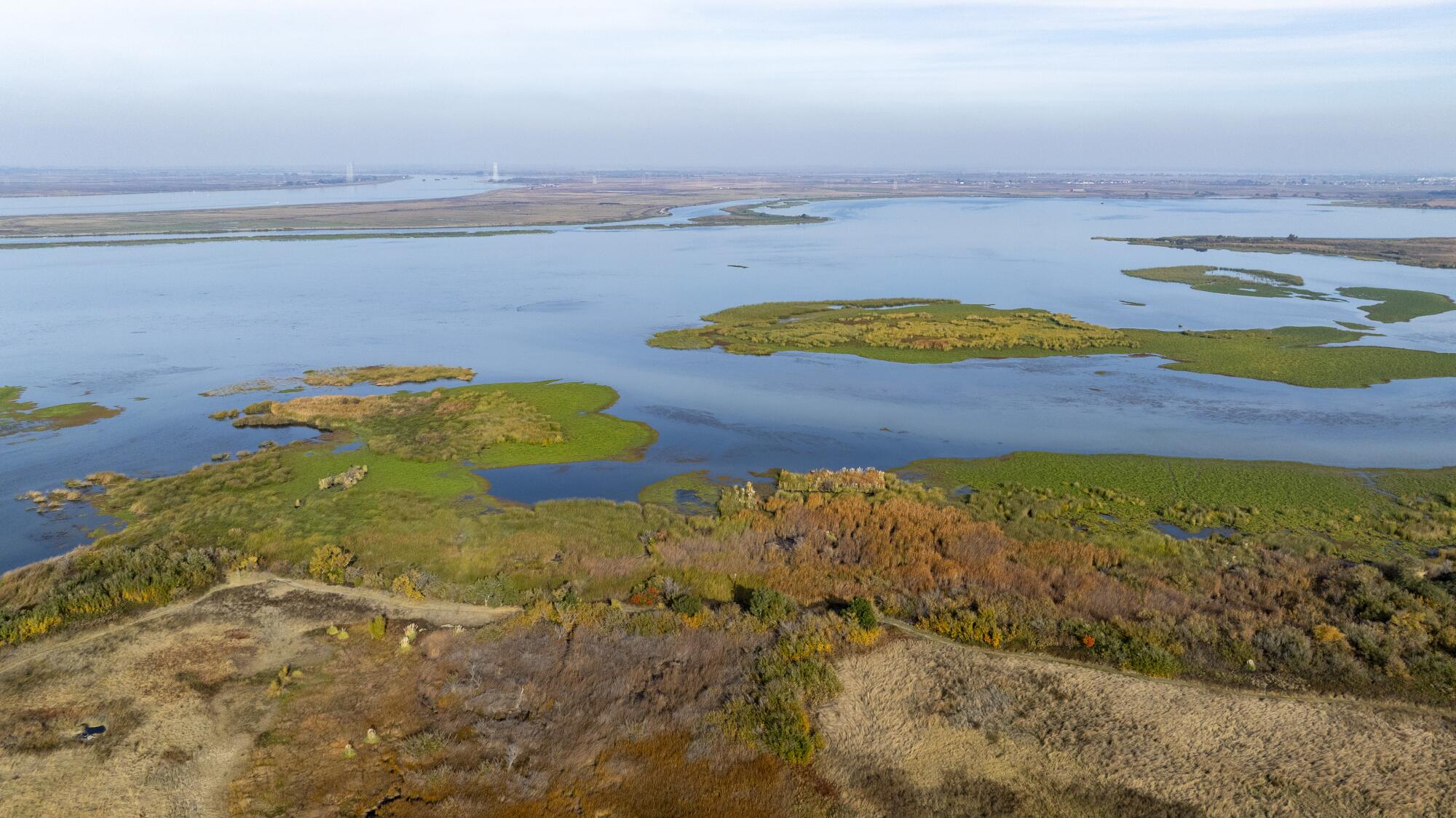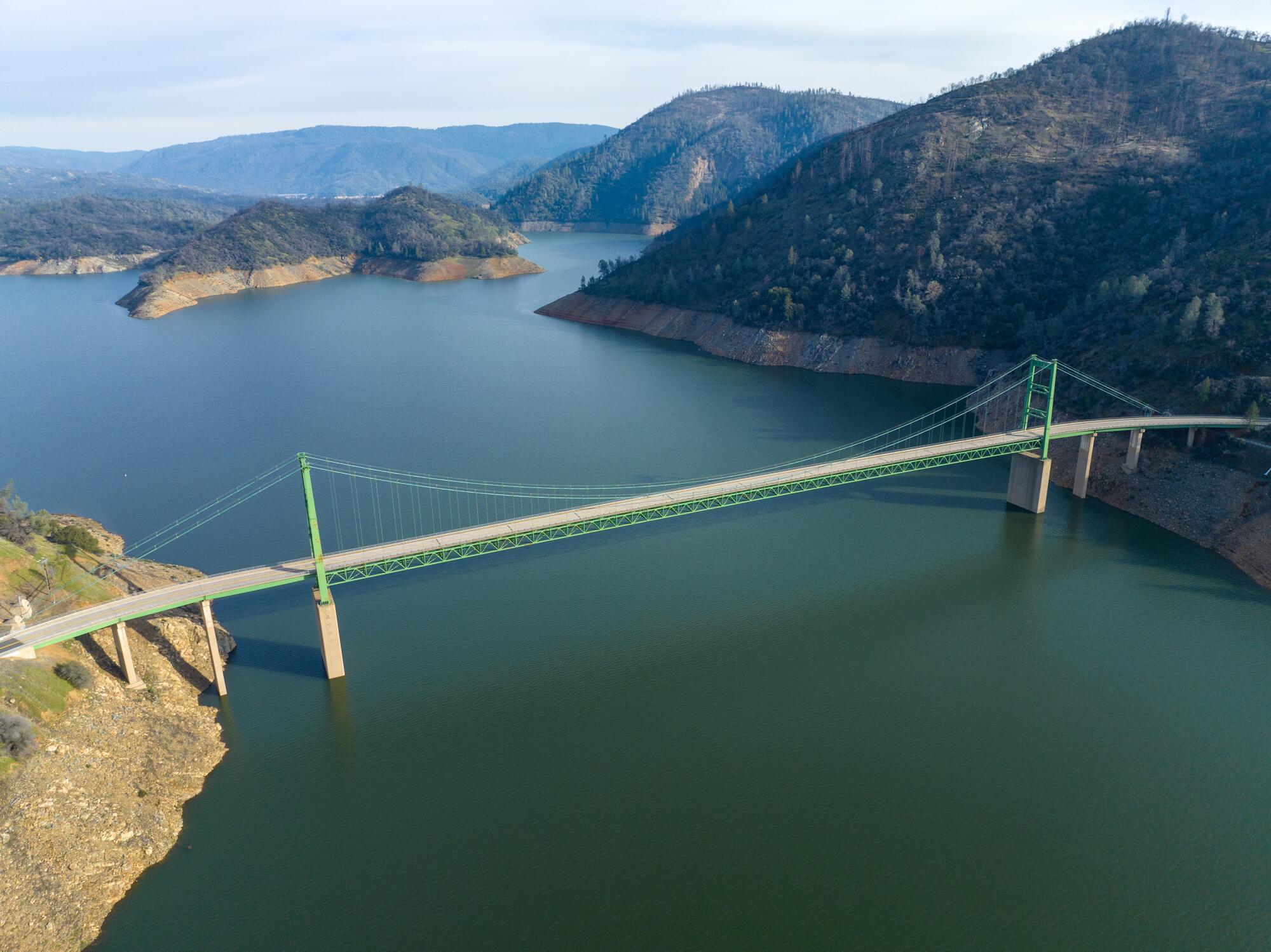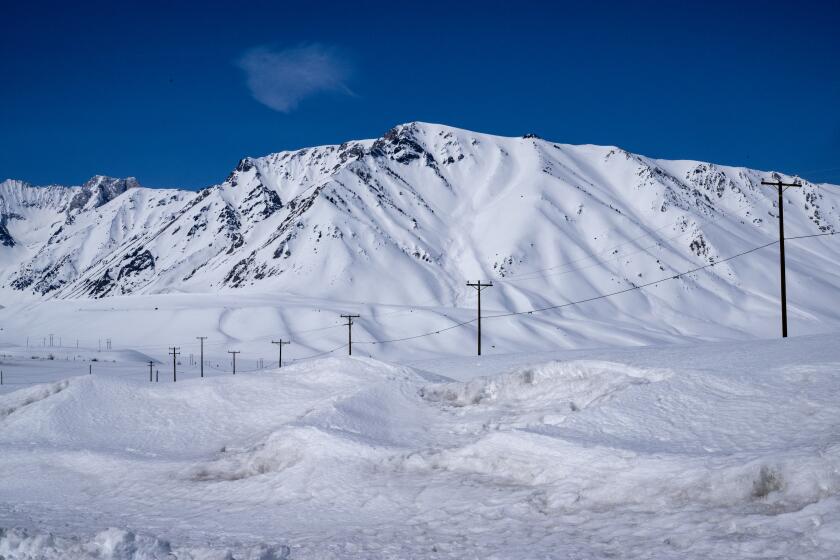
- Share via
California’s mountains are covered with snow, reservoirs are mostly filled and hills across the state are sprouting green grass and wildflowers after the latest round of soaking storms.
The snowpack across the Sierra Nevada now stands at 105% of average for this time of year, and state officials will provide an update on conditions Tuesday when they conduct their April snow survey, which is typically when the snowpack reaches its peak.
The state’s major reservoirs are at 116% of average levels, and are set to rise further as snowmelt streams in.
After a second wet winter, the state is heading into spring and summer with boosted water supplies.
“It puts us in very good shape,” said Felicia Marcus, a water researcher at Stanford University. “Any time you get to average, that’s a great thing.”
Aggressive and impactful reporting on climate change, the environment, health and science.
She said the ample snow and rain this year provide the state some breathing room, but shouldn’t diminish the urgency of planning for the next severe drought and the effects of climate change.
“We’re on borrowed time,” Marcus said. “We need to save more water, even in the wet and the normal years, to get us through the increasingly frequent and drier dries that are inevitably going to come.”
In the last decade, California endured two severe droughts, and then came the historic series of atmospheric rivers of 2023, which brought one of the biggest accumulations of snow on record and triggered damaging floods in parts of the state.
This winter began with unusually dry conditions, but initial fears of a “snow drought” faded as storms in February and March pushed the snowpack to average levels.
This graphic plots a 20-year history of the Sierra snowpack, recalling several other wet years and many more recurring spells of drought.
Precipitation has been slightly above average statewide so far this year. And no part of California is currently in drought conditions, according to the U.S. Drought Monitor’s data.
Water levels in the state’s largest reservoirs in Northern California are well above average levels for this time of year. Shasta Lake is now 92% full and continuing to rise with runoff from the latest rains, while Lake Oroville is at 88% of capacity.
In Southern California, Diamond Valley Lake is also nearly full.

Marcus, a former chair of the State Water Resources Control Board, said the reprieve this year buys the state a bit of time to advance conservation efforts in cities and farming areas, and to invest in projects to recycle wastewater, capture stormwater and recharge groundwater.
“It doesn’t mean we take our foot off the gas pedal,” she said. “Because every year could be the first year of a 10-year drought.”
Even with the state’s reservoirs at healthy levels, California continues to face complex water management problems, such as struggling fish populations and the depletion of groundwater in many farming areas.
Chronic shortages of supplies from the Colorado River, a key source for Southern California, are also forcing water managers to make plans for scaling back water use.
For Southern California’s cities, however, this year’s storms and the substantial amounts of water stored in reservoirs are expected to keep supplies flowing reliably — a dramatic change from 2022 and early 2023, when shortages led to mandatory drought restrictions for millions of residents.
The Metropolitan Water District of Southern California, which delivers supplies to cities and local agencies that serve 19 million people, now has a record amount of water stored. That 3.4 million acre-feet of water, banked in various reservoirs and underground storage areas, equates to nearly three years’ worth of imported water, and a large portion of it accumulated thanks to conservation efforts, said Adel Hagekhalil, the MWD’s general manager.
“We in Southern California have done a great job in managing our water and reducing our water use,” Hagekhalil said.
While two wet years are helping the region’s water outlook for now, he said, the district’s officials are continuing to focus on long-term plans to ensure supplies during more severe droughts supercharged by climate change.
“We may be out of drought for the time being, but we’re not out of drought for the future,” Hagekhalil said. “This is the future climate, and we need to prepare for it.”
Climate change will push snow higher in California’s Sierra Nevada by the second half of the century, bringing more winter rain and faster mountain runoff.
Last month, California increased the water allocations that suppliers will be able to receive this year from the State Water Project to 30% of their full allotments. That level of water deliveries “puts us in balance” with current water demand, Hagekhalil said, enabling the MWD to not draw down its stored supplies this year, and instead keep those reserves for when they’re needed.
Hopefully, he said, the latest storms will bring another increase in the state’s water allocations.
“That puts us in a place where we are storing water everywhere we can,” Hagekhalil said.
“Every drop that we can now store is a drop that we have available for the future,” he said. “This is the climate whiplash. We’re going to see hotter and drier days, and probably a number of years of drought coming to us, so this is the time to capture the water and store it.”
In the Sacramento-San Joaquin River Delta, the center of the state’s water system, a recent increase in the deaths of fish at pumping facilities has prompted criticism from environmental groups and led to limitations on pumping.
“Overall, our pumping has been low throughout the year,” said Lenny Grimaldo, environmental director for the State Water Project. “We’ve seen a lot of protections triggered for species.”
The powerful pumps at state and federal pumping facilities reverse the flow of water in parts of the south delta, and fish can be sucked into the pumps or eaten by predators. Some fish are regularly captured at the facilities and released.
State officials said the estimated losses of endangered winter-run Chinook salmon and threatened steelhead trout at the state and federal pumping facilities surpassed annual take limits on March 21, which prompted discussions among multiple government agencies about additional measures to protect fish.
As a result, Grimaldo said, state and federal officials have kept pumping to levels that they deemed are “protective of minimizing additional losses of fish but also protective of water supply.”
Environmentalists are calling for federal intervention after 4,000 threatened fish were killed by pumps operated by the State Water Project and the Central Valley Project.
The pumps that supply the aqueducts of the State Water Project and the federally managed Central Valley Project have been operating at a little more than one-third of combined capacity.
The state’s water withdrawals have been reduced since February to protect migrating fish, and in the last week, pumping was slightly increased based on data suggesting that this level of pumping “is not drawing additional steelhead into the zone of influence of the pumps,” said Mary Fahey, a spokesperson for the state Department of Water Resources.
State officials believe “protections for steelhead have been suitable for winter-run salmon as well,” Fahey said. She said the uptick in pumping will be short-lived because rules to protect another fish species, longfin smelt, take effect this month.
Meanwhile, other debates over long-term water management are continuing.
Gov. Gavin Newsom and his administration are supporting plans to build Sites Reservoir, the state’s first new large reservoir in decades, as well as the proposed Delta Conveyance Project, a 45-mile tunnel that would transport water beneath the delta.
Newsom’s current plan for adapting to a hotter, drier climate predicts that California could lose 10% of its water supply by 2040.

State water regulators are considering alternatives for new water quality standards that will determine how much water may be drawn from the delta.
In farming areas in the Central Valley, local water agencies are starting to plan for mandatory reductions in agricultural water use to comply with the state’s groundwater law, which calls for curbing overpumping by 2040.
And for urban areas, the state water board is considering new conservation rules that will require each city or local supplier to meet a locally tailored water-use budget. After an initial proposal encountered criticism from water agencies, the board’s staff issued a revised proposal that includes less stringent water-saving standards and would reduce the number of suppliers that need to make large cutbacks.
The changes were supported by water agencies. But environmental groups and conservation advocates have objected to the weakened plan and urged the state to adopt strong water-efficiency standards to help the state prepare for more severe droughts and hotter temperatures.
Marcus said she agrees with the conservation camp and thinks it’s short-sighted to roll back the requirements to the extent state officials are proposing.
“We’re in a climate emergency and a water emergency that’s decadal at minimum,” Marcus said.
“The red alert is on for this, and conservation is the most cost-effective in the long run for communities,” she said. “We’ve got to definitely do a much better job of cutting back on our water use in the most creative ways we can come up with.”











